CONTENTS
Larry, Moe, and Babe
First NBA Game – I
First NBA Game – II
The Hoosiers Hollywood Ignored
1956 U.S. Olympic Team
First Black SEC Coach
When March Went Mad
The 7-0 Game
A Reed Not Shaken by the Wind
Basketball
Snapshots Index
Basketball
Magazine
Golden Rankings Home
Back to Top |
Larry Brown and Doug Moe both starred at North Carolina. Yet neither played in the NBA.
- Brown played at UNC from 1961-3. At 5'9, the Brooklyn-born Brown was considered too short for the NBA. However, he was a member of the USA Gold-medal team at the 1964 Olympics. After playing several years for Akron in the semi-pro NABL, he was an assistant to Dean Smith at his alma mater when the American Basketball Association announced it would begin play for the 1967-8 season.
- Also Brooklyn-born, the 6'6" Moe made All-American twice for the Tarheels. He was drafted in the 7th round in 1960 by the Detroit Pistons. However, he was caught up in the betting scandal of 1961 when 37 players from 22 colleges were arrested for accepting gifts from a gambling ring led by Jack Molinas. Moe had turned down a bribe offer. However, he was banned from the NBA because he failed to report the offer to authorities.
|
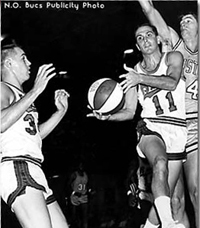
Larry Brown (R) and Doug Moe (L) |

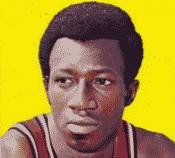
Gerald Govan
|
Babe McCarthy had been named the coach of the New Orleans Buccaneers franchise in the new league. At the NCAA Final Four in 1967, Babe talked to Dean Smith about possible players for the new team. Dean put Babe in contact with Brown who in turn called his old pal Moe: "If you play, I'll play." So they signed on as the first two Buccaneers for $5,000 (Moe) and $2,500 (Brown).
McCarthy stitched together a good team.
- Brown and Moe recommended F Jesse Branson from Elon (NC) College and C Gerald Govan, who played with Moe in Italy.
- Babe convinced two of his former players at Mississippi State to join: G Leland Mitchell and G Red Stroud.
- Another SEC alumnus, C Austin "Red" Robbins of Tennessee, came on board.
- Five-year NBA veteran Jackie Moreland from Louisiana Tech left the insurance business to return to the hardwood.
- In the first ABA draft, the Bucs chose Grambling G James Jones in the first round and F Ron Widby, another Vol (who was also a punter), in the fifth.
The Bucs, playing at Loyola Field House, averaged nearly 3,000 per game. The ABA featured the 3-point shot and the red, white, and blue ball. New Orleans won the Western Division regular season with a 48-30 record.
In the playoffs, the Bucs knocked off the Denver Rockets 3-games-to-2, then dispatched the Dallas Chapparals in the division finals, 4-1.
|
New Orleans met the Pittsburgh Pipers for the first ABA championship. The Pipers were led by 6'9" Connie Hawkins, who, like Moe, had been banned from the NBA after the 1961 scandal, although, unlike Moe, Hawkins had accepted some loans from gamblers. Connie was a forerunner of Dr. J (Julius Erving). He held the ball out with one hand in the key before taking several quick, long strides to the goal.
With home court advantage because of their 54-24 regular season, Pittsburgh prevailed in seven hard-fought contests. Your intrepid reporter attended several of the games in New Orleans. I seem to recall that at least the final game from Pittsburgh was televised on a local station.
Brown and Moe played one more year in New Orleans before moving to the Oakland Oaks of the ABA. Both later made the NBA as head coaches. Moe is currently an assistant in Denver while Brown, who won the title with the Pistons in 2004, heads the Charlotte Bobcats. The Hornets celebrated the 40th anniversary of the Bucs reaching the ABA finals when the Bobcats came to town in December 2008 . Larry joined his old teammates on the court just before the second half began.
|
 Connie Hawkins
Connie Hawkins |
Reference: Gametime: The Official Program of the New Orleans Hornets, December 10, 2008
|
Friday, November 1, 1946: Maple Leaf Garden in Toronto
The first game of the brand new Basketball Association of America matched the Toronto Huskies against the New York Knickerbockers. Toronto gained the distinction of hosting the opening game because the rest of the league began play the next night. However, in hockey-mad Toronto, the Maple Leafs controlled the Garden on Saturday nights. In a sense, it was fitting that a Canadian city would stage the first regular season game of the fledgling league. After all, wasn't the inventor of basketball, James Naismith, a Canadian born in Ontario province? And wasn't this the first professional basketball game in the U.S.'s northern neighbor?
The game provides a glimpse into basketball right after World War II.
- Tickets sold for $0.75 to $2.50. A newspaper ad promised that any fan taller than 6'8" George Nostrand, the Huskies' tallest player, would be admitted free. 7,090 attended – none taller than Big George.
- In attendance were BAA Commissioner Maurice Podoloff as well as Ned Irish, the President of the Knicks.
- At eight o'clock, the teams began warming up. The Huskies conducted a seminar of sorts to acquaint fans with the variety of shots they would see in the game: right- and left-handed layups and hook shots, two-handed set shots, and underhanded FTs. Since no one on either side employed the new one-handed shot popularized by Hank Luisetti, these were not mentioned.
- The Huskies had little home court advantage since they had practiced only once on the new court, which was laid over the ice surface. The Plexiglass backboards were not yet standard at that time either.
The coaches provided a contrast in background and approach to the game.
- Knicks' coach Neil Cohalan was New York through and through. A star player and later coach at Manhattan College, he had the job from Irish for one year until Joe Lapchick would take over after completing his last season at St. John's University.
- 6'5" 270 lb "Big Ed" Sadowski, another New York boy, was player-coach of the Huskies. Ed had survived several pro leagues that had preceded the BAA. Literally throwing his weight around on the court, Ed scored most of his baskets with a sweeping right-handed hook shot that was virtually unstoppable.
- Both teams played the "East Coast offense": "passing, screening, cutting either to or away from the ball, slicing off the pivot for the old give-and-go, and shooting only the traditional set shots, hooks, and layups." Four Huskies executed the standard weave offense with Sadowski anchoring the middle on either side of the 6' lane. With no shot clock to force the issue, a team typically passed and passed the ball until a player either broke to the basket himself or passed to an open teammate. If all else failed, the post player would make a move on his opponent.
Continued below ...
|

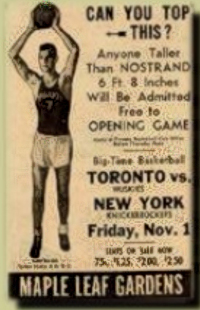
Ad for the First NBA Game
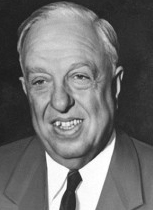
Maurice Podoloff
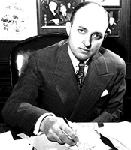
Ned Irish
|
|
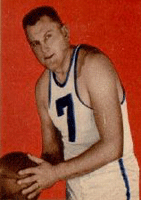
Ed Sadowski

George Nostrand
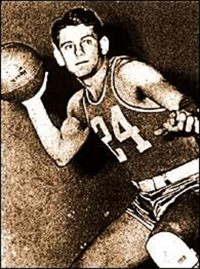
Ossie Schectman
|
Friday, November 1, 1946: Maple Leaf Garden in Toronto
The game began at 8:30.
- Nostrand won the tip for the home team over 6'10" Bob Cluggish. Both were typical of the big men of the time, tall but slow and not agile or capable of jumping very high off the ground.
- The Huskies controlled the ball for nearly a minute before passing to Sadowski, who missed a hook shot.
- The Knicks grabbed the rebound and hurried into the front court. G Ossie Schectman passed to Leo "Ace" Gottlieb who bounced the ball back to Schectman driving to the goal. Ossie dribbled once and tossed up a two-handed scoop shot for the first of over six million points that have been scored in the BAA/NBA. It is an interesting fact that both Schectman and Gottlieb were Jewish (as was Podoloff). Both players are in the Jewish Sports Hall of Fame.
Late in his life, Schectman reflected on basketball in 1946.
The ball was made of leather, and it was darker-colored and much heavier. There was a rubber bladder inside that would have to be pumped full of air, usually at a gas station. And the outside of the ball was sealed tight with leather laces. The laces were slightly raised from the rest of the surface, so if you were dribbling and the ball landed on the laces, it wouldn't bounce up straight and you could easily lose control.
The two officials provided part of the entertainment for the evening.
- The veteran Pat Kennedy not only called fouls but demonstrated them. For instance, he mimicked blocking by putting his hands on his hips and hopping. He'd often holler "Oh, no you don't!" when calling a violation. In 1959, he became the first referee inducted into the Naismith Basketball Hall of Fame.
- Nat Messenger had his own flair. He would whack his forearm when calling a hacking foul. Later in that first season, some players began to suspect that Messenger was fixing the outcome of games for gamblers. Their suspicions proved well-founded.
The Knicks raced to a lead.
- At the end of the first 12-minute period (two minutes more than college quarters at that time), the visitors led 16-12. They widened the lead to 33-18 before Sadowski rallied the Huskies to a 37-29 deficit at the half.
- Early in Q3, Sadowski picked up his fifth foul and was disqualified. Nostrand replaced his coach and led a Toronto comeback. His layup gave the Huskies their first lead of the contest, 44-43, which widened to 48-44 going into Q4.
- For some reason, the refs decided to put their whistles away and let the players go at it. The result was a ragged, physical final period. As the game wound down, the fans chanted "Bi-a-satti!" They wanted to see the only Canadian on either roster in action. Hank Biasatti was a 6'4" grad of Assumption College. With three minutes remaining, Sadowski bowed to their wishes. This move backfired, however, as the Knicks took advantage of Biasatti's weak D to pull out a 68-66 victory.
- Sadowski led all scorers with 18 in only a little more than a half. Gottlieb topped the visitors with 14.
Articles on the game revealed the inexperience of Canadian reporters with basketball. Sadowski's fouls were described as "roughing" and "cross-checking."
The New York Knicks, of course, still compete in the NBA, which got its name when the BAA merged with the rival National Basketball League after the 1948 season. The Huskies, alas, lasted only one season before disbanding in the summer of 1947. Pro basketball didn't return to Canada until the Toronto Raptors in 1995.
|
|
The Hoosiers Hollywood Ignored
It took over fifty years, but Oscar Robertson's jersey at Crispus Attucks High School in Indianapolis was finally retired in February 2009. The ceremony was long overdue considering that the team Robertson played on in 1954-5 became the first all-black team to win a state championship in the U.S.
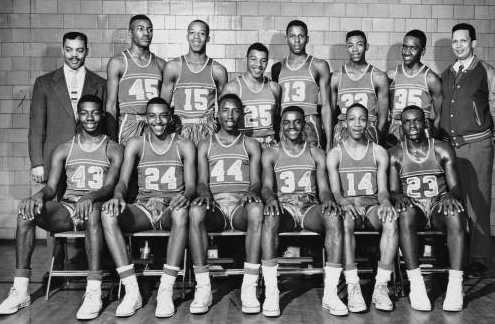
Crispus Attucks 1955 Indiana State Champs; #43 is Oscar Robertson. Coach Ray Crowe stands behind Oscar.
Crispus Attucks High School has an interesting history.
- The school was opened in 1927 exclusively for black students even though Indianapolis already had a mixed race school system. However, the three high schools in the city were hardly fully integrated. Athletics and extra-curriculars were largely segregated, and some classrooms even had segregated seating. As a result, a segment of the black community pushed for a new school exclusively for blacks. However, other black leaders opposed the step back to segregation.
- One of the white residents who pushed the high school was D. C. Stephenson, the Ku Klux Klan grand dragon. When a lawsuit to stop the school failed, construction went forward. The original name chosen was Thomas Jefferson High School. However, a petition drive resulted in the school being christened after the first black man killed in the Revolutionary War.
After opening in 1927 with 1,300 students in a facility built for 1,000, Attucks fought an uphill battle to gain acceptance in the Indiana High School Athletic Association.
- The IHSAA refused Attucks membership on the grounds that, since the school had no white students, it was not a public school.
- It was not until 1933 that member schools were even allowed to play against Attucks.
- Finally, in 1942, CAHS gained membership in the IHSAA.
Because its gym was so small, Attucks became a high school version of the Harlem Globetrotters, playing all their games on the road.
- Since many of the all-white Indianapolis schools refused to play CAHS, most of its games were played in small towns outside the city where the gyms were packed to see the up-tempo athletic brand of basketball the visitors played.
- The team often could not find a place to eat in many towns.
From 1950-7, the Crispus Attucks Tigers compiled an incredible record.
- CAHS won six regional championships, four semi-state championships, and consecutive state titles in 1955 and 1956.
- The record during that span was 179-20, including a record 45 games in a row.
- The 1956 team went undefeated.
- The coach who started this remarkable string in 1950, Ray Crowe, predated another Indiana legend, Bobby Knight, in insisting on discipline on and off the court. To play, you had to maintain your grades, never miss school, and avoid smoking and drinking.
Before each game, Crowe reminded his team that they were playing seven opponents, the other team plus the officials. His motto was to score the first 10 points for the officials, then concentrate on the opponent. Nevertheless, there were incidents of blatant bias.
- In the final minute of a tied 1953 playoff game against Shelbyville, future Globetrotter Hallie Bryant drove to the basket only to have an opponent player knock him down to save the game.
- Officials called charging, and the FTs gave Shelbyville a 46-44 win.
- The call was so blatantly wrong that five Indianapolis News writers signed an editorial in protest.
- However, the Indiana Officials Association supported the call just before voting 40-7 against admitting a black official into the organization.
In 1954, Crowe's team lost to Milan in the state tournament. Don't recognize the name Milan? That's the school whose team was the genesis of the movie "Hoosiers."
Finally, in 1955, the Tigers won the championship, finishing 30-1.
- They defeated New Albany in the semifinals.
- Indiana tradition called for the losing team's cheerleaders to join the winners' for the final game. The two squads united to form an integrated unit for the first time in state history.
- Robertson's 30 points led Attucks to an easy 97-74 win over another black school, Roosevelt of Gary.
The victory helped break down racial barriers in Indianapolis. The team was invited to dine at a downtown restaurant, the first time Robertson and some of his teammates had ever eaten in a sit-down restaurant. Schools that previously had snubbed Attucks now begged them to play in their gym so they could lure a big crowd. And schools that had not admitted blacks now started recruiting them. However, Crowe never won the coach of the year award in the state, a phenomenon Robertson calls "a complete travesty."
The first white student attended CAHS in 1971. Because of declining enrollment, Attucks became a junior high in 1986. Twenty years later, it was converted into a medical magnet school for grades 6-12. When it resumed its basketball program, school officials approached Robertson about retiring his number. However, Oscar refused to cooperate unless the eight former Tigers who made the Indiana Basketball Hall of Fame were also honored. The ceremony finally took place at a CAHS game at Conseco Fieldhouse.
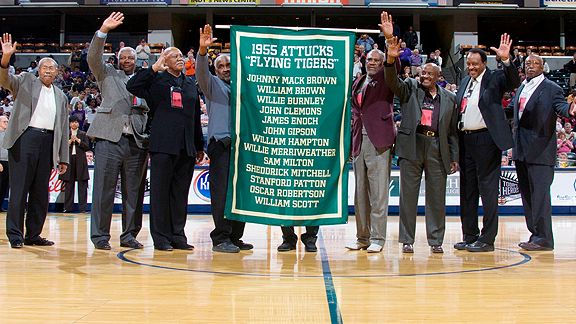
Ceremony Honoring Oscar Robertson and Other Indiana High School Legends
|
|
"This team is as good as any ever assembled." That was the assessment of Gerald Tucker, coach of the United States basketball team that won the Gold Medal at the 1952 Olympic Games in Melbourne, Australia.
The U.S.A. continued its stranglehold on the Olympic basketball competition, winning all four that had been staged to that point. The team was led by 6'9" C Bill Russell and 6'1" G K. C. Jones who had just led the San Francisco Dons to two straight NCAA championships. Since the Olympics did not permit professional athletes from competing in any sport at that time, none of the squad members had played in the NBA. Russell had been drafted by the St. Louis Hawks but immediately traded to the Boston Celtics. However, Russell postponed signing a contract and reporting to the Celtics so that he could play in the Olympics.
The rest of the squad:
- Carl Cain, 6'3" Iowa star whose team had lost to USF in the 1956 finals
- Bill Hougland, 6'5", who had graduated from Kansas in 1952 and played Air Force and AAU ball and had already won a Gold Medal at the '52 Games
- James Walsh, a 6'4" 1952 grad of Stanford who starred on Marine and AAU teams
- William Evans, a 6'4" G who finished at Kentucky in 1954, then played on the Air Force All Stars team for two years
- Burdette Haldorsson, 6'9" All-American from Colorado who led the Big 8 in scoring two straight years (and who also won a Gold Medal on the 1960 US squad)
- Ronald Tomsic, 5'11", another Stanford grad who had played several years of AAU ball
- Richard Boushka, who graduated from St. Louis in 1955 before playing AAU basketball for a year
- Gilbert Ford, a 6'4" 1954 graduate of Texas who had played for the Phillips 66 team and then the Air Force
- Robert Jeangerard, 6'3", another Colorado grad who had played AAU ball most recently
- Charles Darling, 6'8", a 1952 Iowa grad who had been drafted by the Rochester Royals of the NBA but had spurned their offer to play AAU for Phillips 66
At a time when no other countries had developed basketball players to the extent that the U.S. had, Tucker's team was never pressed by anyone. Even the finals against the USSR was a 89-55 blowout. Russell declared this "my proudest moment" and added, not very convincingly, "I have no plans at this time for a professional career. All I can think about right now is that we won." Of course, he shortly thereafter signed with the Celtics for whom he played 14 years, the last four as player-coach, winning 11 NBA championships and capturing five MVP awards.
Although drafted by the Celtics in 1956, Jones didn't join Boston until 1959. He played for ten years and won eight championships. He later coached 12 years in the NBA including five with the Celtics. He coached the Larry Bird-led squad to NBA championships in 1984 and 1986. He and Russell are both enshrined in the Basketball Hall of Fame.
|
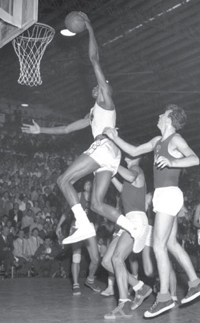
Bill Russell at the 1956 Olympics

K.C. Jones
|
|
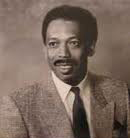
Wade Houston
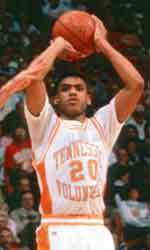
Allan Houston
|
In 1989, Wade Houston became the first black head coach in any sport in the 58-year history of the SEC when Tennessee hired him to replace Don DeVoe as head of the Vol basketball program.
This was not the first time Wade had broken a barrier. Growing up in Alcoa TN, he was not offered a scholarship by UT in 1962 when he graduated from high school because the SEC was still segregated. Instead, he became the first African-American player at Louisville.
In 1976, as coach of Louisville Male High, he steered his star player, Darrell Griffith, to Denny Crum's Cardinals. Crum rewarded Houston by hiring him as an assistant in his program. During Wade's 13th at Louisville, Houston's son Allan signed a grant-in-aid to play for the Cardinals. However, when Wade got the Tennessee job, Crum released the younger Houston from his scholarship so that he could play for his father in Knoxville.
The Cherokee Country Club in Knoxville traditionally awarded a free membership to each head football and basketball coach at Tennessee. However, it did not extend that privilege to Houston, who would have become the first black member of the club. UT AD Doug Dickey and football coach Johnny Majors both resigned from Cherokee in protest. The furor died when Houston refused to make an issue of it. (The club did not admit its first black member until 2002 and still has only one.)
Allan starred at Tennessee from his freshman year on. He averaged 20.3 ppg as a freshman, then 23.7, 21.1, and 22.3 the next three seasons. Allan became the all-time leading scorer at UT with 2,801, which is still second all-time in the SEC behind Pete Maravich. Houston finished his career as the 13th highest scorer in NCAA history (he's still 14th). However, one great player does not make a team.
Although popular as a person, Wade Houston led the Vols to only two winning seasons in five years.
- 1990: 16-14 overall, 10-8 in SEC, NIT second round
- 1991: 12-22/3-15
- 1992: 19-15/8-8, NIT second round
- 1993: 13-17/4-12
- 1994: 5-22/2-14
So Wade Houston lasted one year after his son's graduation. He has never coached again and currently runs a trucking company in Louisville.
Allan had a fine NBA career that would have been greater if not for injuries. After three years with Detroit, Houston played nine years with the Knicks. He averaged 17.3 ppg for the twelve years.
|
|
The 1979 NCAA championship game is considered the watershed in the history of college basketball. The game matched Michigan State against Indiana State. Or, more accurately, it pitted Magic Johnson against Larry Bird.
In an era before widespread penetration of cable TV (ESPN launched six months after the game), hardly anyone had seen Bird play. His 33-0 Sycamores of the Missouri Valley Conference were never on national TV at a time when only a few weekend games were shown nationally by CBS, NBC, and ABC. Being from the Big Ten, Magic was much more familiar to viewers across the land. In his opening remarks at the start of NBC's telecast of the finals, Bryant Gumbel told the audience, "If you haven't seen Bird, you're in for a treat."
MSU's 75-64 win in Salt Lake City garnered a 24.1 Nielsen rating, which is still the highest for a basketball game, college or pro. (The rating indicates the percentage of sets tuned to the game. So it is a figure that can be compared across the decades even as the population increases. The 2008 Kansas-Memphis final got what is considered a healthy number today: 12.1.) Johnson won because he had a much better supporting cast. Magic scored 24 while Greg Kelser added 19 and an unheralded G named Terry Donnelly popped in 15. Meanwhile the swarming Spartan D frustrated Bird at every turn. He scored 19 points but made only 7 of 21 shots and committed six turnovers. MSU had prepared for Bird's passing by having Magic work against the starters in practice.
To capitalize on the momentum generated by the finals, the NCAA expanded the field of teams from 40 to 64 for 1980. Even before it went live that fall, ESPN had already signed a deal to broadcast the early rounds of the 1980 tournament. "Our network was really built on college basketball," says Bill Rasmussen, who helped create the Bristol CN sports giant. The late Al McGuire, who called the ISU-MSU game along with Dick Enberg and Billy Packer, said, "The college game was already on the launching pad, then Bird and Magic came along and pushed the button."
Of course, Magic and Bird dominated the NBA in the 1980s. So out of favor in the late 70s and early 80s that the week night games in the Finals were shown on tape delay at 11:30 pm ET on CBS, the league made large leaps in popularity over the next decade.
It is interesting to follow what happened to the two head coaches in that fateful 1979 clash.
- Jud Heathcote, the Spartans' coach, won the title in his third year at the helm in East Lansing. However, in seven subsequent trips to the NCAA tournament, he never returned to the Final Four. He retired in 1995 with a .603 career winning percentage. He turned the program over to his assistant, Tom Izzo, who has led the Spartans to five Final Fours, winning the championship in 2000. Heathcote has a coaching "family tree" that will stand up against anybody's. He was seen sitting near Magic at the 2009 Finals when UNC bested MSU.
- 36-year-old Bill Hodges was in his first season at ISU in 1979. As an assistant to Bob King, Hodges inherited the head job when King suffered a brain aneurysm before the season. Hodges was named national coach of the year after the 33-1 season. However, with Bird in the NBA the following year, the Sycamores fell to 16-11 in 1980-81. After back-to-back 9-18 seasons, Hodges resigned. He assumed he'd get another Division I gig but underestimated the prevailing opinion that he just lucked out by being Larry Bird's coach. Bill didn't make it back to Division I until 1991 when he was hired by Mercer. After reaching the Atlantic Sun Conference tournament final two years in a row but losing, the Bears fell to 3-20, at which point Hodges resigned. At age 66, he is a high school history teacher in Roanoke VA [as of 2009]. He still cherishes the hand-written letter he received from John Wooden after the '79 final.
|

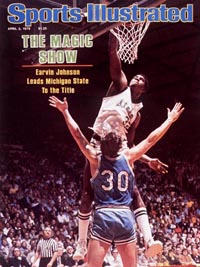
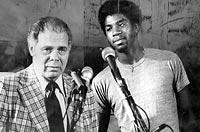
Jud Heathcote with Magic Johnson
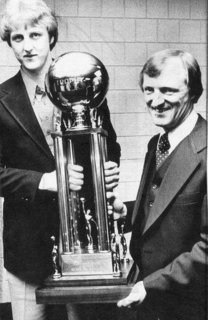
Bill Hodges with Larry Bird
|
|
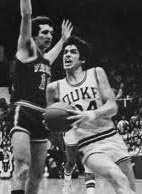
Jim Spanarkel |
Perhaps the strangest game in the hallowed North Carolina-Duke series is "The 7-0 Game" on February 24, 1979. Why is it called "The 7-0 game?" Because that was the halftime score. The game also spawned what has become a standard basketball chant.
- UNC's Dean Smith, on his way to becoming a Hall of Fame coach, decided that he could not win the last game of the regular season at Cameron Indoor Stadium on Jim Spanarkel's Senior Night playing straight. So after Duke took a quick 2-0 lead, NC went into its four corners O to pull the Blue Devils out of their 2-3 zone.
- Coach Bill Foster was content to wait out the Tarheels, who proceeded to hold the ball for 11 minutes.
- Finally, Rich Yonakor shot an airball. Duke rebounded and Spanarkel made a 3-point play for a 5-0 lead. (Any 3-point plays in 1979 were the traditional kind since the 3-point line had not been instituted yet.)
- Carolina held the ball until the last minute when Yonakor shot another airball. Duke scored in the last seconds for a 7-0 halftime lead. After a desperation UNC shot fell short at the buzzer, the student section yelled the first "airball" chant to honor the fact that Carolina had not even hit the rim in the first half.
- Smith abandoned the stall tactic in the second half, and Duke won 47-40.
- The shot clock wasn't added to the college game until 1985. However, whenever it was discussed in the years leading up to the change, the 7-0 game was offered as evidence of the need to introduce the clock.
|
|
A Reed Not Shaken by the Wind
A big question mark loomed over the New York Knicks' preparation for Game 7 of the 1970 NBA Finals against the Los Angeles Lakers at Madison Square Garden.
Would their leading scorer (21.7) and leading rebounder (13.9), C Willis Reed, be able to play?
- Reed, from Grambling State, had torn a muscle in his thigh early in Game 5. The Knicks went to a small lineup in the second half and won a surprising victory 107-100 to take a 3-2 lead in the series.
- Willis's injury kept him out of Game 6. The Lakers ran away 135-113 in LA to force the deciding game.
- Los Angeles had three future Hall of Famers in their lineup:
- G Jerry West (31.2 ppg)
- C Wilt Chamberlain (27.3)
- F Elgin Baylor (24.0)
- Chamberlain had suffered a knee injury in the ninth game of the season and was feared lost for the year. As the playoffs approached, he had insisted on returning to the lineup.
Unknown to his teammates, Reed arrived at the Garden at 9 am the day of the final game.
- He worked with trainer Danny Whelan to try to get ready to play that night.
- Still, when the Knicks arrived in the locker room, Willis could barely walk. F Bill Bradley told his teammate: "Willis, if you can just give us a few minutes, that's better than anyone else that we have."
- NY coach Red Holzman had to fuss at the team to get them to leave the locker room for the game because they kept going into the training room to check on Reed.
- So when the Knicks came on the court, they had no idea whether Willis would play.
- Reed's dramatic entrance right before the tipoff is one of the most electrifying moments in NBA history. Then he hit hit the first two baskets of the game while hobbling up and down the court before taking a seat on the bench.
- G Walt Frazier said that the Knicks were just as surprised as everybody else when Reed came out of the locker room. Frazier noticed the astonisment on the faces of West, Chamberlain, and Baylor. "We've got these guys," he said to himself.
- Inspired by Reed's appearance, the Knicks beat the Lakers 113-99 in a game that was not as close as the final score would indicate. Frazier talled 36 points and 19 assists.
- "He [Reed] gave us a tremendous lift just going out there," Holzman said after the game. "He means a lot to the spirit of the other players.
|
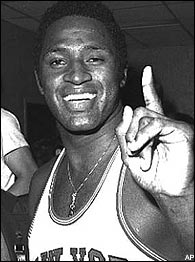
Willis Reed
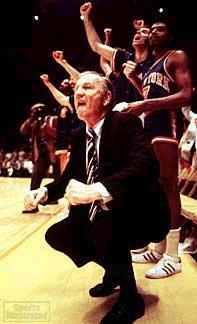
Red Holzman
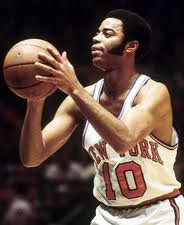
Walt Frazier
|
|